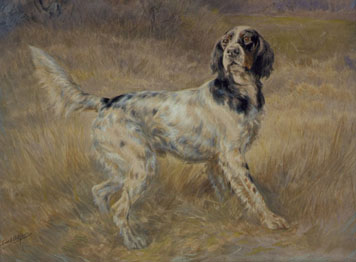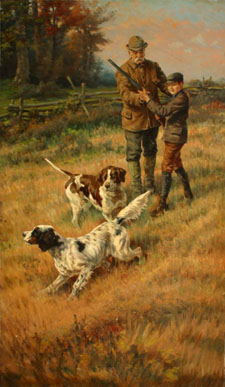From its founding, the United States has been known as a hunting paradise attracting those who relied on hunting for food but also later those who considered it to be a sport. To market their smokeless gunpowder to these hunting enthusiasts, DuPont in the late 1800s began commissioning artwork for use in advertising its smokeless gunpowder specifically for this audience. From these paintings, DuPont produced calendars, postcards and lithographs that could be either given away or purchased for a small price. In the museum collection, there are more than 40 of these paintings representing the work of such notable artists as Charles Schreyvogel, Edmund H. Osthaus, N. C. Wyeth, Lynn Bogue Hunt, C. Everett Johnson, Phillip R. Goodwin, Gustav Muss-Arnott, Charles DeFeo and Carl Rungius.
One of the first oil paintings DuPont acquired for this use is Buffalo Hunting on Horseback by Charles Schreyvogel (1861-1912). Around 1893, the Hoboken, New Jersey, artist went to William F. Cody’s Wild West Show and became fascinated with the west. Later that year he made his first trip to Colorado and Arizona. This trip and others created numerous drawings that he used to base his paintings on. A contemporary of Frederick Remington, Schreyvogel won the top prize at the 1900 National Academy of Design Exhibition in New York. The painting that won, My Bunkie, is in the collection of the Metropolitan Museum of Art.

More than half of these paintings were made by Edmund H. Osthaus (1858-1928) who was born in Germany and immigrated to the United States in 1883. At the Toledo Academy of Fine Arts in Ohio, he became the director and after it closed, devoted himself to painting. Most of his artwork featured his passions of hunting or fishing but his specialty quickly became hunting dogs. In the 1890s, Osthaus began painting sporting artwork for DuPont. Some of the paintings are portraits of champion hunting dogs such as the series he started in 1896 and continued until 1910 of the watercolor portraits of National Field Trial Championship winners including the 1900 winner “Lady’s Count Gladstone” as seen here. From the thirteen paintings that resulted in this series, DuPont created a set of postcards that could be ordered from the company for ten cents.

Other Osthaus works in the collection featured hunters with their dogs. Generations Have Used DuPont Powder is a romanticized oil painting of a grandfather teaching his grandson how to hunt. DuPont used this image on their 1903 annual calendar. From sporting artwork, DuPont later commissioned paintings that displayed other products in use such as dynamite in agriculture and mining, Pyralin dresser sets for women and DuCo car paint. Most of these images have faded away with history but not the sporting artwork! The resulting postcards, calendars and prints remain still collectible today.

Debra Hughes is the Museum Curator of Collections and Exhibits at Hagley Museum and Library.
